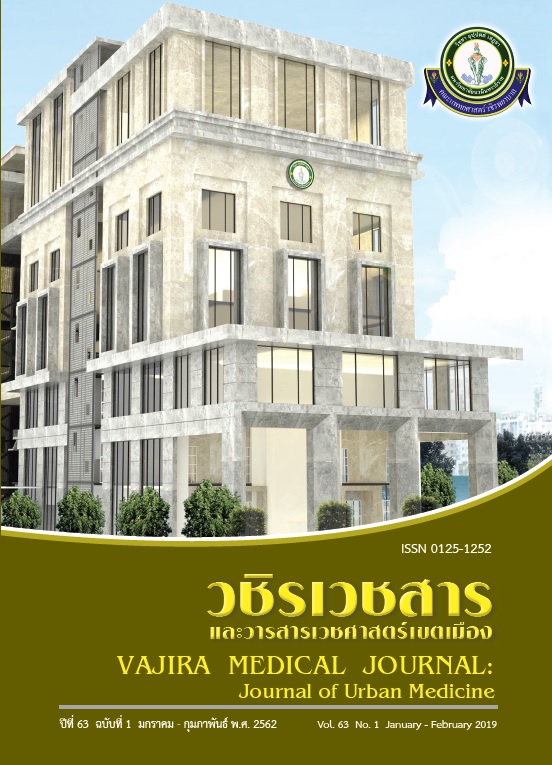Stress and Factors Affecting Level of Stress among Buddhist Monks in Bangkok
Main Article Content
Abstract
Objective: To identify level of stress and the factors those influence level of stress among Buddhist monks in Bangkok.
Methods: This research is a cross sectional descriptive study. The data collected from 205 monks in Dusit and Nongchok district by using purposive sampling method. The instruments were composed of socio-demographic factors questionnaires and Suanprung Stress Test - 20 (SPST-20). Statistical analysis included descriptive statistics, Chi-square test and multiple logistic regression.
Results: Exactly 70.7 percent of the sample disclosed low to moderate level of stress and 29.3 percent disclosed high to severe level. The statistically significant factors related to level of stress are age (p<0.001), year of ordination (p=0.026) and financial status (p=0.011). Monks aged between 20-40 years old had higher stress comparing to other age groups. Monks with year of ordination from 1 to 5 years were more stressful than monks with over 5 years ordination. And monks who had shortage of money had higher level of stress than monks who had adequate spending. Significant predictive factors of high to severe level of stress are monks age between 20 to 40 (OR adj = 3.52, 95% CI: 1.28-9.66, p = 0.015) conflict in the temple (OR adj = 3.55, 95% CI: 1.38-9.17, p = 0.009) and shortage of money (OR adj = 3.37, 95% CI: 1.40-8.12, p = 0.007).
Conclusion: To alleviate stress in monks, stress screening should be regularly used, especially among high risk groups, namely monks age between 20 to 40, have conflict in the temple, and have shortage of money. Nevertheless, direction of the solution should be design within the appropriate context and culture of the society.
Downloads
Article Details
References
2. Manuspaiboon B. Thai Tipitaka version of Mahachulalongkorn-rajavidyalaya from perseverance to wisdom to the Thai Buddhism. In: Mahachulalongkornrajavidyalaya committee, editors. Collect diamonds from scriptures of the Tipitaka. Bangkok: Mahachulalongkornrajavidyalaya Publishing, 1999.
3. PhraThammakosachan. Dhamma using in the
solution of life's problems. Bangkok: Thammasapa
publishing house, 2000.
4. Nupan U. Stress from studying of monks and novices in the Pali ecclesiastical education of the central region[dissertation]. Bangkok: Silpakorn University; 2007.
5. Farmer RE, Monahan LH, Hekeler RW. Stress management for human services. Michigan: Sage publication; 1984.
6. Suksavage A. Stress coping among Buddhist monks in Bangkok metropolitan[dissertation]. Bangkok: Mahidol University; 2005.
7. Wongjirasawad S. Mental health of Buddhist monks in Bangkok metropolis[dissertation]. Bangkok: Chulalongkorn University; 2000.
8. Odkamdee S. Factors effecting mental health of the elderly monks in district of Kantharalak, si sa ket province[dissertation]. Bangkok: Silpakorn University; 2005.
9. Chuchvarat P. Factors affecting health behavior of Buddhist Monks in Muang district, Phayao province [dissertation]. Phayao: Boromarajonani college of nursing, Phayao; 2008.
10. Jearajit C. A situation and buddhist management of stress: a case study of sangha in Nakornnayok and Srakaew provinces. Journal of MCU Social Science Review 2017;4:154-67.
11. Buathed D. Buddhist Monks’ health : a model of holistic health care by community participation in upper central Thailand. Journal of Cultural Diversity 2005;1:102-9.
12. Mahatnirunkul S, Pumpaisanchai W, Tarpunya P. Suanprung stress test, SPST-20. [Internet]. 1997 [cited 2017 Mar 17]. Available from: http://www.dmh.go.th/test/stress/.
13. Jaric R. Stress of Thai people[Internet].2017 [cited 2018 Jun 17]. Available from: http://www.ba.ru.ac.th/document/conference/RUNC_7-12.pdf.
14. Orem DE. Nursing : concepts and practice. 6th ed. Columbia: Canada; 2001.
15. Khummuan C , Vorayingyong A, Lohsoontorn V. Prevalence and related factors of stress among grade 12 students in Buriram province. Thammasat Medical Journal 2016:4;642-9.16. Phruektayanont S, Ngernprasertsri N. The job stress of the thai police officers. Political Science Review Journal 2016;2:165-91.
17. Junthanasombat P. Prevalence of stress and factors correlated with stress among residents in training in King Chulalongkorn Memorail Hospital[dissertation]. Bangkok: Chulalongkorn University; 2002.
18. Preechapermprasit D. The Sangha and private properties. Journal of buddhist studies Chulalongkorn University 2010:1;55-85.
19. Sariwat L. Psychology in daily life. Bangkok: Odian store; 2001.
20. Suwantong P. Stress is psychological pressure[Internet]. 1988 [cited 2018 Jun 8]. Available from: http//thesis.or.th.
21. Phrakhruwisutthanantakun. The Administration of Wat Khaochonpran Ratchaburi Province [dissertation]. Bangkok: Mahachulalongkornrajavidyalaya University; 2011.
22. Namsombat R. Temple management in good governance: case study of Wat Saketrachaworamahmwihara, Pomprapsattruphai district, Bangkok[dissertation]. Bangkok: Sripatum University; 2016.


